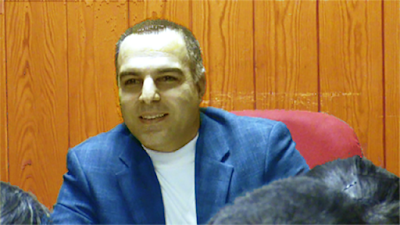Əlirza Quluncu (Alirza Quluncu) - May 24, 2014
 |
| Artum Dinc |
"May protests were an event that surpassed the nature of protest over a cartoon. Since the Pahlavi era, it was a rebellion of a people facing humiliation, discrimination, and injustices," said sociologist Artum Dinc in an interview with Voice of America, evaluating the nature of the May 2006 uprising. According to him, this was the first time in the past few decades that the Turks of Azerbaijan in Iran rose up as a community to defend their national interests regardless of their social status.
The sociologist, who currently resides in Ankara, himself was arrested and tried for his role in mass actions organized in Azerbaijani cities against the racist cartoon published in an Iranian newspaper in May 2006. Artum Dinc underscored the significant number of people taking to the streets during the May uprising, highlighting the diverse layers of society that participated in the protests, including women, men, workers, and even some groups within the government, such as the Basijis (semi-military volunteer forces).
Artum Dinc stated that the protests began dynamically and expanded rapidly. "It was a dynamic awakening, and there was no serious organization behind it; the people were organizing dynamically. This could be seen in the slogans chanted; most of the slogans were created by the people themselves," he noted.
According to Artum Dinc, many people from various social groups joined the May uprisings because the protests gained legitimacy in the eyes of the people: "There was legitimacy there because the people expressed their protests culturally, civilly, and peacefully."
He argues that, during the May uprising, the people expressed their outrage at the published cartoon and their protest against the injustices they had faced for years. "It wasn't just about a cartoon; there was text, too. It was a written cartoon. But the protests were an event that surpassed the nature of that written cartoon. It was a rebellion of a people facing humiliation, discrimination, injustice, and marginalization," said Artum Dinc.
Dinc also drew attention to the fact that the racist cartoon was disseminated by an official state organ, a newspaper, and suggested that this also contributed to the escalation and popularization of the protests.
"The cartoon, originating from a state newspaper, ignited widespread outrage, with many asserting that targeting Turks in Iran—a marginalized group enduring systematic racism—was unjust, thus justifying the reaction and believing that the public could bear the costs of the protests," he clarified.
The sociologist also shared his thoughts with Voice of America on the May uprising's positive and negative aspects and outcomes.
Artum Dinc pointed out some public events he observed during the May uprising, including "understanding and realizing ethnic discrimination," "testing the state of indifference among Turks and overcoming fear," "increasing the people's sensitivity to humiliation and ridicule," and "the agenda of Persianization policy being raised by large masses and various segments of society, especially by Turks."
Link to the original text: https://www.amerikaninsesi.org/a/may-2006-tabriz/1920841.html
